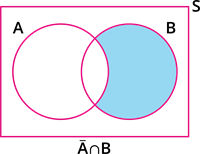PDF chapter test TRY NOW
Theorem:
If A and B are two events associated with a random experiment, then prove that:
(i) P(A \cap \overline B) = P(\text{only A}) = P(A) - P(A \cap B)
(ii) P(\overline A \cap B) = P(\text{only B}) = P(B) - P(A \cap B)
Proof for the theorem:
Statement (i):
The Venn diagram representing A \cap \overline B is as follows:

To prove: P(A \cap \overline B) = P(A) - P(A \cap B)
Proof for statement (i):
By the distributive property of sets, we have:
1. (A \cap B) \cup (A \cap \overline B) = A \cap (B \cup \overline B)
Here, B \cup \overline B = S.
Thus, (A \cap B) \cup (A \cap \overline B) = A \cap S
Hence, (A \cap B) \cup (A \cap \overline B) = A.
2. (A \cap B) \cap (A \cap \overline B) = A \cap (B \cap \overline B)
Here, B \cap \overline B = \phi.
Thus, (A \cap B) \cap (A \cap \overline B) = A \cap \phi
Hence, (A \cap B) \cap (A \cap \overline B) = \phi.
Therefore, from the above properties it is clear that the events (A \cap B) and (A \cap \overline B) are mutually exclusive and its union is set A.
So, P(A) = P\left[(A \cap B) \cup (A \cap \overline B)\right]
\Rightarrow P(A) = P(A \cap B) + P(A \cap \overline B)
\Rightarrow P(A \cap \overline B) = P(A) - P(A \cap B)
Therefore, P(A \cap \overline B) = P(\text{only A}) = P(A) - P(A \cap B).
Hence, proved.
Statement (ii):
The Venn diagram representing \overline A \cap B is as follows:

To prove: P(\overline A \cap B) = P(B) - P(A \cap B)
Proof for statement(ii):
By the distributive property of sets, we have:
1. (A \cap B) \cup (\overline A \cap B) = (A \cup \overline A) \cap B
Here, A \cup \overline A = S.
Thus, (A \cap B) \cup (\overline A \cap B) = S \cap B
Hence, (A \cap B) \cup (\overline A \cap B) = B.
2. (A \cap B) \cap (\overline A \cap B) = (A \cap \overline A) \cap B
Here, A \cap \overline A = \phi.
Thus, (A \cap B) \cap (\overline A \cap B) = \phi \cap B
Hence, (A \cap B) \cap (\overline A \cap B) = \phi.
Therefore, from the above properties it is clear that the events (A \cap B) and (\overline A \cap B) are mutually exclusive and its union is set B.
So, P(B) = P\left[(A \cap B) \cup (\overline A \cap B)\right]
\Rightarrow P(B) = P(A \cap B) + P(\overline A \cap B)
\Rightarrow P(\overline A \cap B) = P(B) - P(A \cap B)
Therefore, P(\overline A \cap B) = P(\text{only B}) = P(B) - P(A \cap B).
Hence, proved.
